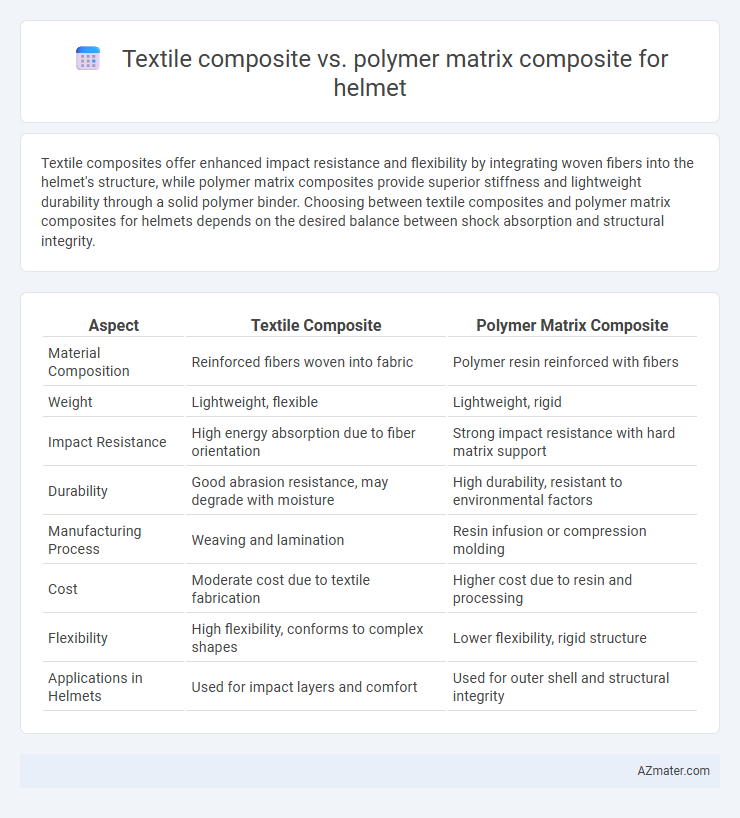Textile composites offer enhanced impact resistance and flexibility by integrating woven fibers into the helmet's structure, while polymer matrix composites provide superior stiffness and lightweight durability through a solid polymer binder. Choosing between textile composites and polymer matrix composites for helmets depends on the desired balance between shock absorption and structural integrity.
Table of Comparison
| Aspect | Textile Composite | Polymer Matrix Composite |
|---|---|---|
| Material Composition | Reinforced fibers woven into fabric | Polymer resin reinforced with fibers |
| Weight | Lightweight, flexible | Lightweight, rigid |
| Impact Resistance | High energy absorption due to fiber orientation | Strong impact resistance with hard matrix support |
| Durability | Good abrasion resistance, may degrade with moisture | High durability, resistant to environmental factors |
| Manufacturing Process | Weaving and lamination | Resin infusion or compression molding |
| Cost | Moderate cost due to textile fabrication | Higher cost due to resin and processing |
| Flexibility | High flexibility, conforms to complex shapes | Lower flexibility, rigid structure |
| Applications in Helmets | Used for impact layers and comfort | Used for outer shell and structural integrity |
Introduction to Helmet Materials
Textile composites and polymer matrix composites are critical materials in helmet manufacturing due to their high strength-to-weight ratios and impact resistance. Textile composites use woven fibers like Kevlar or carbon fiber embedded in a polymer matrix, offering enhanced flexibility and energy absorption during impacts. Polymer matrix composites, typically consisting of thermosetting resins reinforced with fibers, provide rigidity and durability, making them ideal for protective helmets in sports, military, and industrial applications.
Understanding Textile Composites
Textile composites in helmets utilize woven fabrics such as carbon, Kevlar, or fiberglass, enhancing impact resistance and energy absorption through fiber orientation and layering. Polymer matrix composites embed these textile fibers within a polymer resin, typically epoxy or thermoplastic, to achieve lightweight structures with superior strength-to-weight ratios. Understanding textile composites involves analyzing fiber architecture, resin compatibility, and manufacturing techniques to optimize helmet performance in terms of durability and protective capabilities.
Overview of Polymer Matrix Composites
Polymer Matrix Composites (PMCs) for helmets consist of a polymer resin reinforced with fibers such as glass, carbon, or aramid, offering high strength-to-weight ratios and excellent impact resistance. These composites provide superior energy absorption and durability compared to traditional textile composites, making them ideal for protective gear. Advanced PMC materials enable helmets to achieve enhanced performance through improved toughness, lightweight design, and resistance to environmental degradation.
Key Performance Criteria for Helmets
Textile composites offer superior impact resistance and enhanced flexibility due to their woven fiber structure, making them ideal for energy absorption in helmet liners. Polymer matrix composites provide higher stiffness and strength-to-weight ratios, crucial for outer shell durability and penetration resistance. Key performance criteria for helmets include impact attenuation, weight optimization, and durability, where polymer matrix composites excel in structural integrity, while textile composites ensure comfort and shock dispersion.
Impact Resistance Comparison
Textile composites offer superior impact resistance for helmets due to their woven fiber architecture that efficiently distributes and absorbs energy upon impact. Polymer matrix composites provide high strength and stiffness but often suffer from brittle failure mechanisms under severe impact conditions. The interlaced textile fibers in textile composites enhance toughness and reduce penetration risk, making them more effective in mitigating impact forces compared to polymer matrix composites.
Weight and Comfort Considerations
Textile composites used in helmets generally offer superior comfort due to their flexibility and breathability while maintaining lightweight properties. Polymer matrix composites, often reinforced with carbon or glass fibers, provide higher structural strength but can be heavier and less comfortable over extended wear. Weight efficiency in textile composites enhances user comfort by reducing fatigue, making them preferred in applications where prolonged use is critical.
Durability and Lifespan of Composites
Textile composites, often reinforced with woven or non-woven fibers like aramid or carbon, offer enhanced durability and impact resistance ideal for helmet applications due to their ability to absorb and dissipate energy efficiently. Polymer matrix composites, typically consisting of thermoset or thermoplastic resins combined with reinforcing fibers, provide a balance of lightweight properties and long-term structural integrity under environmental stressors such as UV exposure and moisture. The lifespan of helmets made from textile composites generally exceeds that of polymer matrix composites because of superior fatigue resistance and damage tolerance inherent in fiber architecture and matrix bonding.
Manufacturing Processes and Scalability
Textile composites offer enhanced flexibility in weaving techniques, allowing precise control over fiber orientation and thickness, which improves helmet impact resistance. Polymer matrix composites, commonly using thermosetting resins like epoxy, provide streamlined manufacturing through processes such as resin transfer molding (RTM), facilitating faster cycle times suitable for mass production. Scalability favors polymer matrix composites due to their compatibility with automated molding systems, whereas textile composites require more labor-intensive fabric layering, potentially limiting large-scale helmet fabrication efficiency.
Cost Analysis: Textile vs Polymer Matrix Composites
Textile composites generally offer lower production costs for helmets due to the use of woven fabrics like fiberglass or carbon fiber combined with epoxy or polyester resins, enabling cost-efficient manufacturing and material availability. Polymer matrix composites, particularly those incorporating advanced polymers such as thermoplastics or thermosetting resins, tend to increase costs due to higher raw material prices and more complex processing techniques. The final helmet cost is influenced by factors including material weight, durability requirements, and desired impact resistance, with textile composites frequently preferred for budget-sensitive applications.
Future Trends in Helmet Composite Technology
Textile composites for helmets offer superior flexibility and impact absorption, while polymer matrix composites provide enhanced strength-to-weight ratios and thermal resistance, driving innovation in protective gear design. Emerging trends in helmet composite technology emphasize integrating nanomaterials and smart sensors within polymer matrices to improve real-time impact detection and energy dissipation. Future developments focus on hybrid composites combining textile reinforcements with advanced polymers to optimize durability, comfort, and safety performance in helmets.

Infographic: Textile composite vs Polymer matrix composite for Helmet
 azmater.com
azmater.com